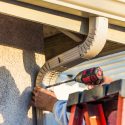Implementing a commercial gutter system involves navigating through various challenges that can impede the smooth installation and functionality of the system. This article discusses common installation issues and offers practical solutions and tips to ensure a seamless gutter installation process.
Solutions for Common Installation Issues
Improper Slope:
A frequent issue is the incorrect slope of gutters, leading to poor water flow and pooling. To resolve this, ensure that gutters are installed with a precise slope towards downspouts, generally recommended to be 1/4 inch drop for every 10 feet of gutter.
Incorrect Sizing:
Gutters that are too small for the area they serve can easily overflow during heavy rainfall. Calculate the square footage of the drainage area and match it with the appropriate gutter size and downspout capacity to handle the expected water volume.
Poor Seaming and Joining:
Leakage at the seams and joints is another common problem. Opting for seamless gutters where possible can mitigate this issue. Where seams are necessary, ensure they are securely sealed and checked regularly for leaks.
Inadequate Downspout Placement:
Downspouts incorrectly placed or spaced too far apart can lead to gutter overflow. Install downspouts at intervals of 20 to 30 feet along the gutter run to ensure effective water diversion.
Tips for a Smooth Gutter Installation Process
Professional Assessment:
Before installation, have a professional assess the property to determine the best gutter system configuration. This assessment should consider roof size, pitch, and the potential volume of rainwater.
Quality Materials:
Invest in high-quality materials that can withstand the local climate and environmental conditions. Durable materials like aluminum, steel, or copper may have higher upfront costs but will offer better longevity and less maintenance.
Regular Maintenance Plan
Establish a maintenance schedule to clean and inspect gutters regularly. This proactive approach can identify potential issues before they become significant problems, ensuring the gutter system remains efficient.
Consider Gutter Guards:
Installing gutter guards can prevent debris from clogging the gutters and downspouts, reducing maintenance needs and ensuring consistent water flow.
Compliance with Regulations:
Ensure that the installation complies with local building codes and regulations. This compliance is crucial for safety standards and to avoid potential legal issues.
Conclusion
Addressing the common challenges of commercial gutter installation requires careful planning, the right materials, and adherence to best practices. By implementing the solutions and tips outlined, property managers and installation professionals can ensure that gutter systems are installed correctly and function efficiently. A well-installed gutter system not only protects the property from water damage but also contributes to its overall well-being and longevity.

